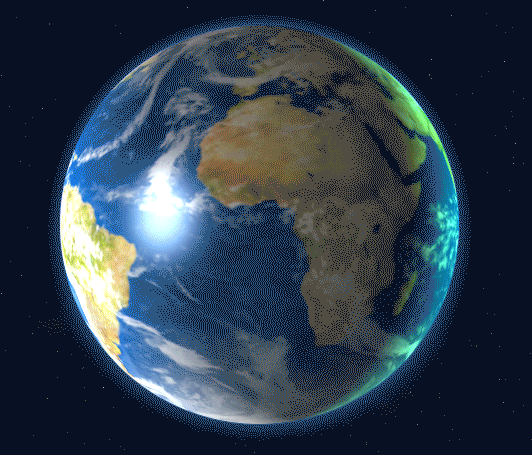Here is the origin story of Earth—the only place we know life to exist.

NASA
Published: April 16, 2025
Last Updated: April 16, 2025
The Big Bang brought the universe into existence more than 13 billion years ago. But it wasn’t until much later—around 4.54 billion years ago—that planet Earth came into being.
Earth was born in a turbulent pocket of space, where intense collisions, extreme temperatures and cosmic chaos all contributed to the conditions that would eventually allow life to take root.
“If you think about the situation that provides you with the least habitable Earth, it is probably the one we had,” says Teddy Kareta, an astronomer at the Lowell Observatory in Arizona. “And yet, it turned out okay.”
4.6 Billion Years Ago: Enormous Cloud Collapses, Ignites Sun
The solar system as we know it was once nothing more than a massive cloud of gas and dust swirling through space.
Around 4.6 billion years ago, that cloud began to collapse in on itself. This collapse was likely triggered by the shockwaves from a nearby exploding star. Scientists know this collapse was due to a supernova event because the star’s spectacular death released huge amounts of detectable radioactive elements into space—elements that are not typically found in nebulae.
Following the supernova event, much of the gas and dust started to spiral inward, becoming denser and heating up. Eventually, the temperatures reached levels high enough to trigger nuclear fusion, igniting our sun.
4.59 Billion Years Ago: Leftover Material Coalesces into Planets
The remaining gas and dust didn’t simply disappear: they flattened into a spinning disk that resembled a giant pancake, according to NASA. Over time, this material began to condense, forming the giant planets we now know to be Jupiter, Saturn, Uranus and Neptune.
Scientists think both ice giants Uranus and Neptune originally formed twice as close to the sun as they are in the present day and drifted to the outer solar system due to the gravitational forces exerted by Jupiter and Saturn over hundreds of millions of years.
4.5 Billion Years Ago: Birth of Inner Planets, Including Earth
Roughly 4.54 billion years ago, as the sun’s gravity dominated the inner solar system, the smaller planets—Mercury, Venus, Earth and Mars—began to coalesce from rocky material that survived the heat and light of the early sun. Over time, these rocks stuck together and grew into their present planet-sized bodies.
The inner solar system, however, was far from a peaceful place. About 50 to 100 protoplanets larger than the moon collided with the fledgling planets.
Additionally, gravitational interactions due to migration of outer planets like Uranus and Neptune sent asteroids and comets crashing into the inner solar system during an era known as the Late Heavy Bombardment.
“I wouldn’t want to live in the early solar system—I don’t think anyone would,” says Kareta. “There was not just more stuff overall, there was a lot more big stuff.”
One of these large objects, a Mars-sized body nicknamed Theia, collided with a young Earth in a cataclysmic event. The impact threw massive amounts of molten Earth material into space. Over time, this debris came together under gravity to form the moon.
This violent collision may have also altered Earth’s tilt, setting the stage for the planet’s climate to stabilize and allowing life to eventually emerge.
3.8 to 3.5 Billion Years Ago: Life Emerges on Earth
The oldest clear evidence of life on Earth comes from 3.5 billion-year-old rocks in Western Australia, but it did not always survive asteroid impacts.
Around 3.26 billion years ago, a massive space rock—about the size of four Mount Everests—collided with Earth, giving early life an unexpected boost. According to Nadja Drabon, an Earth and planetary sciences professor at Harvard University, the impact likely caused a mass die-off of microorganisms.
However, it also delivered phosphorus, a vital nutrient, into the oceans, setting the stage for life to flourish. A massive tsunami triggered by the impact mixed the ocean waters, making previously inaccessible iron available to surviving lifeforms.
“We think life bounced back really quickly,” says Drabon. “It encountered better conditions than it did before.”
66 Million Years Ago to the Present Day: Chicxulub Asteroid Wipes Out Dinosaurs, Solar System Settles Down
Sixty-six million years ago, a mountain-sized asteroid struck the Yucatán Peninsula in Mexico. The energy released by this collision was so massive that it led to the extinction of nearly 75 percent of all life on Earth, including most dinosaurs.
Today, the solar system is much more stable, with fewer asteroid impacts. Earth’s dynamic geology has erased most of its scars, but the violent history of the solar system is still visible on the moon’s pockmarked surface.
Built upon more than 4 billion years of cosmic events, with many shaping Earth in ways scientists are still uncovering, life now thrives on our planet in remarkable diversity.
Earth remains the only known sanctuary for life in the vast universe, and its story—chaotic as it has been—continues.
